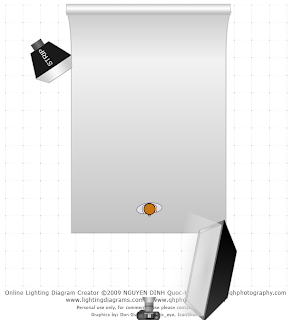
This diagram is responsible for a lot of my non-1 light setups. Yet as I draw/build this diagram, I already know that I can not possibly provide you all the nuances that I apply in this setup.
Again it dawns on me why these diagrams are so pointless when I look at them... there's just so much more in the lighting than just light placement. Volumes of information... books even. Hence the library and wealth of information online about lighting alone.
That being said, here's an example of how I use this setup:

First of all, feather your main light. Don't blast your subject with the center intensity of the light. Also to note are the shadows. The big body shadow on the white paper is from the main light (large softbox). The edge highlight along her body is from the back/rim light. In the diagram I use a gridded stripbox. Sometimes I use a gridded 7" conical reflector (a la AlienBees) but lately I've been using the 36"x12" gridded softbox.
Fortunately for our example, Alex is looking straight forward and we're able to see the entire body. What do we see? Even lighting top to bottom. It's a 50" softbox afterall. We see lots of spill onto the white paper but still some drop off to the right. We also see some good edge definition from the background courtesy of our rim light. From the nose shadow we gather that the main light angle isn't too far above her head and positioning is only slightly to our right, somewhere between 45º and directly above the camera... we'll call it 30º.
This is usually my starting point. From here I start shooting and in this case, Alex starts moving. I'm a big fan of dynamic poses and I don't want her to maintain this forward-looking pose forever. In fact, I expect she'll move as much as 150º to maybe even 180º. As she moves, the shadows change, at which point I reevaluate whether I want to reposition the lights. Most of the time I don't. I have shot this setup enough that I know which angles are flattering to the face (notice I said face and not body because I rarely look at the body in the frame which might be a flaw). There are a few angles where the cheekbones really shine and the definition of the face really pop. I look for these things in the viewfinder. If I don't get it, I ask her to give me these angles (usually later in the set after she's moved around enough).
That brings up the subject of angles and shadows. There's a trade-off going on here. If I want a specific angle of light on her face that produces a specific shadow, I need to move the lights to the exact place that give me that angle. But in order for me to accomplish that, I must break her posing rhythm and my shooting flow. I usually put rhythm and flow above all else. So unless I'm not getting the shot, I never break to change lighting. There are of course exceptions. If I only need 3 seconds to move the mainlight, I'll do it because it's not that disruptive. But I only do that if I know exactly where it's going to go...
Which brings back the subject of modeling lamps. Imperative in the studio and paramount to learning. Use them. Watch them between frames. Watch what the light is doing to the shadows. Too often I see photographers stray from their lights during a set. They get caught up in shooting and forget where their models and lights are. Shoot with intent. Don't forget what you're trying to achieve. Don't get lost in your own shoot.
Talk to the model. If she moves too far off center, bring her back. Ask her to create interesting looks that work with this lighting setup. The setup is simple enough to not bring too many issues into the picture but if we're creative we can enhance the overall effect. Maybe an arm over the head to create more eye shadows? Sure. Whatever works. Speaking of models. Find a good model. The better your model the better your pictures. So much of my photography rests on having a good model. That being said, if you're worth your weight in salt you'll still be able to create impressive frames with a newbie model.
After shooting this lighting setup, a lot of thought goes into the selection process. I'm looking for the same magic that I thinks works best on her face with these lights. I'm looking for specific angles, specific shadows, interesting expressions, but most of all I'm looking for a reason to look at this picture. Again, there's no right answer. Everyone has to create their own style.
Now go out and shoot already!

No comments:
Post a Comment